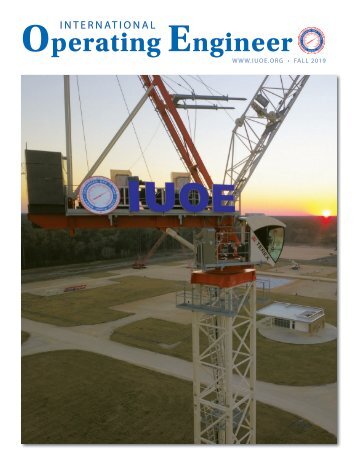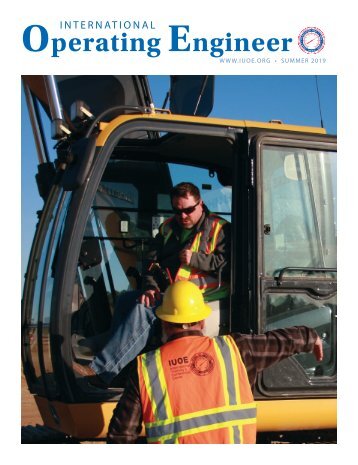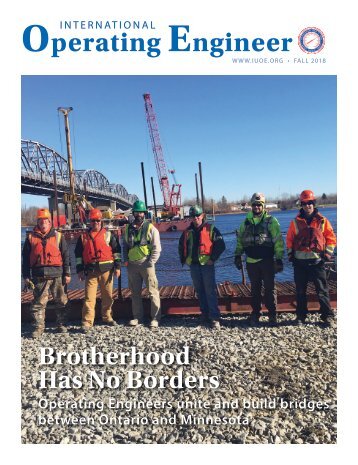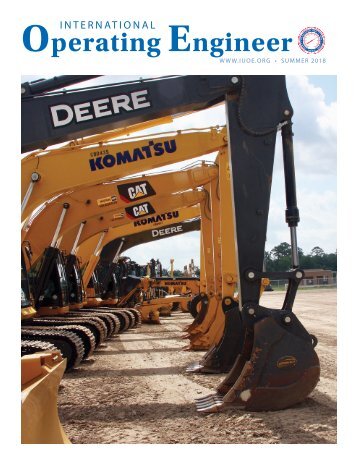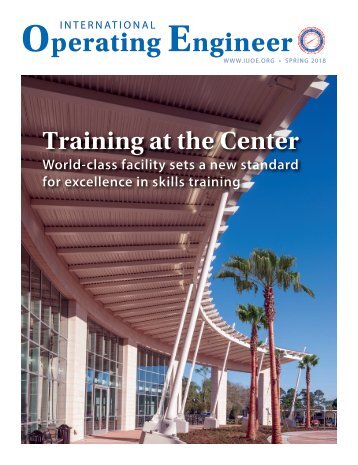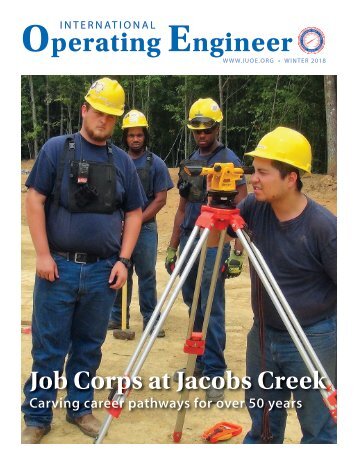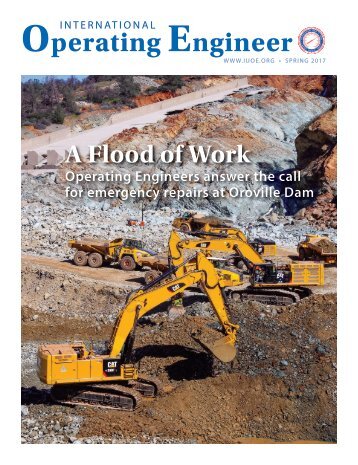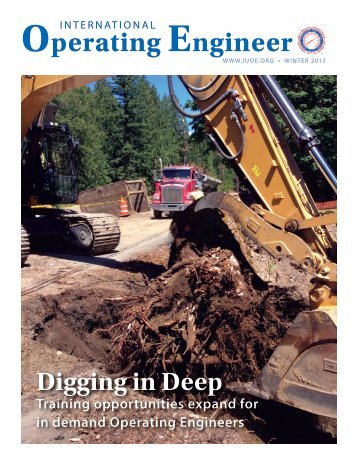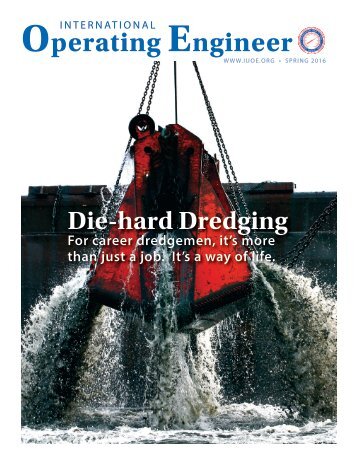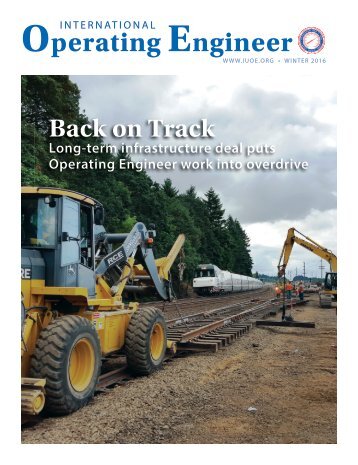125 Years Strong – An IUOE History
- Text
- Wwwiuoeorg
- Vincit
- Omnia
- Engineer
- Convention
- Membership
- Locals
- Operating
- Engineers
INTERNATIONAL UNION OF
INTERNATIONAL UNION OF OPERATING ENGINEERS our brother and sister I.U.O.E. members, our sister local unions and our international union. Your outpouring of kindness, caring and assistance was truly moving.” Business Manager Schiro went on to tell those attending the meeting and, in essence, the entire union: “You opened your hearts and extended your hands to those members in dire need. That is what the I.U.O.E. is all about.” Up & Down: Jackpot to Slump Addressing a growing national healthcare crisis became another chief objective of the I.U.O.E. during the 2000s, and into the second half of that decade the union was working intensely to resolve the issue through collective action such as informationsharing and coalition-building. To support those Among the many women who have impacted their locals throughout the I.U.O.E., Sister Diane Smalec of Local No. 399 in Chicago was a pioneer in many ways, having started her career as Local 399’s first female trainee engineer at Chicago’s Hyatt Regency Hotel and later becoming the first female engineer employed at that hotel, the first female chief engineer at Chicago’s McCormick Place Convention Center and the first female to serve on the local’s Executive Board. Sadly, Sister Smalec was killed in an automobile accident on April 7, 2006, at age 50. efforts, the union established a new Health Care Initiatives Department in 2006 to work with its locals to confront challenges facing their health and welfare funds. The department did this by assisting locals in making informed decisions, offering cost-cutting opportunities for healthcare services, and facilitating communication and the exchange of key information. Meanwhile, work in the pipeline industry in both the U. S. and Canada was thriving – and would continue to flourish for many years to come as, beginning in 2006, related jobs already scheduled for the next three years in the U. S. consisted of 63 projects with a total of more than 10,000 miles of pipe. What’s more, in Alberta, Canada alone, some 12 projects with a total of 2,200 miles of pipe were scheduled at the time. To prepare for that work and more, the international union increased its skills training endeavors and placed particular emphasis on the pipeline sector. In doing so, from November 2006 to April 2007, the union would conduct 14 three-week-long pipeline training programs at different sites around North America. Citing the need to respond to “today’s construction industry,” on March 1, 2006, the I.U.O.E. withdrew from its affiliation on an international level with the A.F.L.-C.I.O Building and Construction Trades Department and joined the Laborers’ International Union and the United Brotherhood of Carpenters in forming the National Construction Alliance (N.C.A.). In explaining the union’s separation from the Trades Department, General President Giblin noted in the Winter 2006 International Operating Engineer that through the N.C.A., the I.U.O.E. would have the “four critical standards” that it could not get in the Trades Department and which eventually led to the disaffiliation: weighted voting by member unions; expedited resolution of jurisdictional disputes; strict budgetary controls; and decisive, effective leadership. Members of I.U.O.E. Local No. 66 of Pittsburgh and Western Pennsylvania and their families participate in the city’s 2006 Labor Day parade, which is one of the largest in the country. The broad goals of the newly created N.C.A. were lifting working and living standards for all construction workers, increasing the union share of the construction market and helping union contractors compete in the construction industry by forging more cooperative working partnerships. In particular, the organization would focus on expanding union presence through organizing in areas where there was little or no union influence; establishing a credible influence on Capitol Hill through enhanced legislative-political activities; and making union contractors more competitive by delivering skilled, quality labor in a moreefficient manner. However, two years later the I.U.O.E. General Executive Board voted on February 28, 2008, to withdraw from the N.C.A. should the laborers “prove unwilling to suitably resolve” jurisdictional disputes with the operating engineers. Subsequently, soon afterward the I.U.O.E. and the carpenters’ union formed the National Construction Alliance II. (The I.U.O.E. would re-affiliate on an international level with all the building-trades unions in 2012 when it rejoined the A.F.L.- C.I.O. Building Trades Department, which would be renamed North America’s Building Trades Unions [NABTU] in 2015. N.C.A. II would end on December 16, 2013, and be replaced in 2014 by the National Infrastructure Alliance, which would be responsible for the administration of the National Heavy & Highway Agreement negotiated between the National Infrastructure Contractors Association and the ironworkers, carpenters, laborers and operating engineers unions.) Back during the mid-2000s, operating engineers with Local No. 12 “hit the jackpot,” as the Winter 2007 International Operating Engineer declared, when construction started in 2006 on MGM Mirage’s massive new .4-billion CityCenter on a 76-acre site in the heart of the Las Vegas Strip. The largest privately financed project in the history of the United States, the 17-million-square-foot CityCenter construction required the use of more than 150 operating engineers working three shifts, six days per week, to complete its six structures, including a 60-story 4,000-room hotel and casino, for its opening in December 2009. LABOR OMNIA VINCIT WORK CONQUERS ALL
- Page 2:
LABOR OMNIA VINCIT WORK CONQUERS AL
- Page 6:
INTERNATIONAL UNION OF OPERATING EN
- Page 10:
INTERNATIONAL UNION OF OPERATING EN
- Page 14:
INTERNATIONAL UNION OF OPERATING EN
- Page 18:
INTERNATIONAL UNION OF OPERATING EN
- Page 22:
INTERNATIONAL UNION OF OPERATING EN
- Page 26:
INTERNATIONAL UNION OF OPERATING EN
- Page 30:
INTERNATIONAL UNION OF OPERATING EN
- Page 34:
INTERNATIONAL UNION OF OPERATING EN
- Page 38:
INTERNATIONAL UNION OF OPERATING EN
- Page 42:
INTERNATIONAL UNION OF OPERATING EN
- Page 46:
INTERNATIONAL UNION OF OPERATING EN
- Page 50:
INTERNATIONAL UNION OF OPERATING EN
- Page 54:
INTERNATIONAL UNION OF OPERATING EN
- Page 58: INTERNATIONAL UNION OF OPERATING EN
- Page 62: INTERNATIONAL UNION OF OPERATING EN
- Page 66: INTERNATIONAL UNION OF OPERATING EN
- Page 70: INTERNATIONAL UNION OF OPERATING EN
- Page 74: INTERNATIONAL UNION OF OPERATING EN
- Page 78: INTERNATIONAL UNION OF OPERATING EN
- Page 82: INTERNATIONAL UNION OF OPERATING EN
- Page 86: INTERNATIONAL UNION OF OPERATING EN
- Page 90: INTERNATIONAL UNION OF OPERATING EN
- Page 94: INTERNATIONAL UNION OF OPERATING EN
- Page 98: INTERNATIONAL UNION OF OPERATING EN
- Page 102: INTERNATIONAL UNION OF OPERATING EN
- Page 106: INTERNATIONAL UNION OF OPERATING EN
- Page 112: INTERNATIONAL UNION OF OPERATING EN
- Page 116: INTERNATIONAL UNION OF OPERATING EN
- Page 120: INTERNATIONAL UNION OF OPERATING EN
- Page 124: INTERNATIONAL UNION OF OPERATING EN
Inappropriate
Loading...
Mail this publication
Loading...
Embed
Loading...
International Operating Engineer
HEADQUARTERS
INTERNATIONAL UNION OF OPERATING ENGINEERS (IUOE)
1125 17th Street, NW
Washington, DC 20036
202 429-9100
CONTACT US
Send us an email here.
©2010 International Union of Operating Engineers. All Rights Reserved.|Terms Of Use|Privacy Statement|Sitemap


